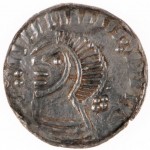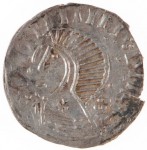 A metal detectorist has discovered two 11th century Viking silver coins near Newcastle in Co Down, Northern Ireland. Brian Morton was scanning a field last May when he found the silver pennies half an inch apart under four inches of mud. He didn’t know he’d found an extremely rare historical treasure. That was formally confirmed last week when a coroner’s inquest in Belfast declared the coins official treasure trove.
A metal detectorist has discovered two 11th century Viking silver coins near Newcastle in Co Down, Northern Ireland. Brian Morton was scanning a field last May when he found the silver pennies half an inch apart under four inches of mud. He didn’t know he’d found an extremely rare historical treasure. That was formally confirmed last week when a coroner’s inquest in Belfast declared the coins official treasure trove.
 Made of 93% silver, the coins are of a rare type known as Hiberno-Manx coins. The rulers of Mann in the first half of the 11th century were Vikings from Scandinavia and from Dublin. Olaf Sigtryggsson, King of Mann in the early 1030s, was the son of Sigtrygg Silkbeard, King of Dublin, and his wife Sláine, daughter of Irish king and national hero Brian Boru. Viking Dublin had its own mint and issued coins which copied English designs. The Hiberno-Manx coins were very rough versions of the Dublin designs.
Made of 93% silver, the coins are of a rare type known as Hiberno-Manx coins. The rulers of Mann in the first half of the 11th century were Vikings from Scandinavia and from Dublin. Olaf Sigtryggsson, King of Mann in the early 1030s, was the son of Sigtrygg Silkbeard, King of Dublin, and his wife Sláine, daughter of Irish king and national hero Brian Boru. Viking Dublin had its own mint and issued coins which copied English designs. The Hiberno-Manx coins were very rough versions of the Dublin designs.
 Despite the political and familial connections between Mann and Dublin and the numismatic mimicry, more than 90% of all known Hiberno-Manx coins have been found on the Isle of Man, which strongly suggests they circulated exclusively as currency on the island itself. The rest were found in Scandinavia. The two discovered by Brian Morton are the first to have been found in Ireland. (There are some in Irish private collections, but they were unearthed elsewhere or their find sites cannot be authenticated.)
Despite the political and familial connections between Mann and Dublin and the numismatic mimicry, more than 90% of all known Hiberno-Manx coins have been found on the Isle of Man, which strongly suggests they circulated exclusively as currency on the island itself. The rest were found in Scandinavia. The two discovered by Brian Morton are the first to have been found in Ireland. (There are some in Irish private collections, but they were unearthed elsewhere or their find sites cannot be authenticated.)
How the coins made their way to the Co Down hinterland remains uncertain, but one possibility is that they were taken during a Viking raid on a nearby monastery at Maghera, the court was told. The discovery may also reflect more peaceful trading or strategic links between the Isle of Man and south-east Ulster.
Robert Heslip, a former curator of coins at the Ulster Museum, said they were probably dropped by someone passing rather than deliberately hidden.
He explained: “I would think that it is more likely to be a loss given that they were separated. Also, two is an odd number. You generally find one or a hoard of these coins.” […]
Dr Greer Ramsey, of National Museums Northern Ireland, said: “We take coinage totally for granted but, prior to the Viking period in Ireland, there wasn’t coinage, and silver was the main form of currency. … The significance is that these coins are really the first that we can say were found in Ireland. It is a measure of contact – that people from the Isle of Man were travelling over.”
Next up for the coins is a valuation by independent experts at the British Museum. They’ll determine the fair market value which will be ponied up by whichever museum wants the coin as a finder’s fee to be split between Morton and the landowner. Local museums are given the opportunity to secure the treasure first, and given the oversized historical significance of these small pennies, I have little doubt the National Museums Northern Ireland, likely the Ulster Museum, will snap them up.
Most likely dropped by Manx Vikings pogoing at an early Stiff Little Fingers concert.
Isn’t it interesting that the Manx coin is still better money that current US coinage – 93% silver, versus none at all!
The Kingdom of Mann and the Isles comprised the Hebrides, the islands of the Firth of Clyde and the Isle of Man from the 9th to the 13th centuries AD. Belfast, so to speak, is an almost natural stop whenever moving from the Isles to Mann, and back.
The Viking trade in slaves from Ireland could have played a certain role here, even if two meager silver coins seem to indicate remnant stock, maybe folk from the next village with ‘Stiff Little Fingers’. After the Norman Conquest, slavery was replaced by feudalism and serfdom.
The legacy of Viking raids can be seen in recent evidence suggesting that approximately 60% of the Icelandic maternal gene pool is derived from Scotland and Ireland, which is much higher than other Scandinavian countries, although comparable to the Faroe Islands.